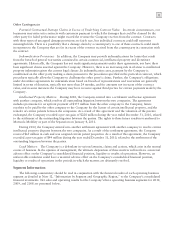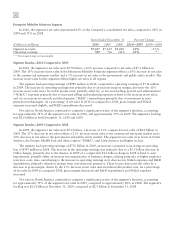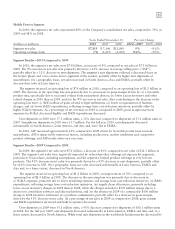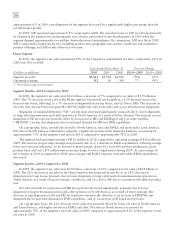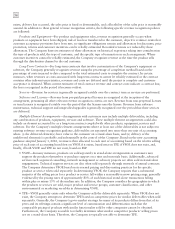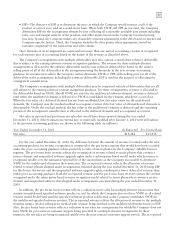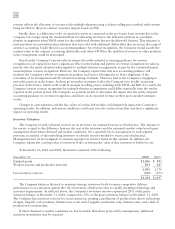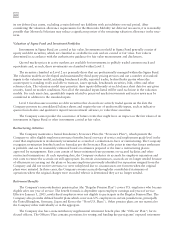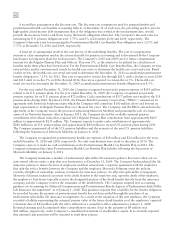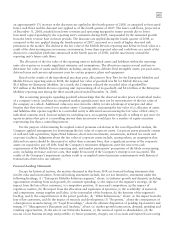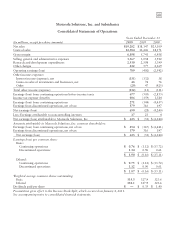Motorola 2010 Annual Report Download - page 67
Download and view the complete annual report
Please find page 67 of the 2010 Motorola annual report below. You can navigate through the pages in the report by either clicking on the pages listed below, or by using the keyword search tool below to find specific information within the annual report.
59
Income Taxes
The Company’s effective tax rate is based on pre-tax income and the tax rates applicable to that income in the
various jurisdictions in which the Company operates. An estimated effective tax rate for a year is applied to the
Company’s quarterly operating results. In the event that there is a significant unusual or discrete item recognized, or
expected to be recognized, in the Company’s quarterly operating results, the tax attributable to that item would be
separately calculated and recorded at the same time as the unusual or discrete item. The Company considers the
resolution of prior-year tax matters to be such items. Significant judgment is required in determining the Company’s
effective tax rate and in evaluating its tax positions. The Company establishes reserves when it is more likely than
not that the Company will not realize the full tax benefit of the position. The Company adjusts these reserves in
light of changing facts and circumstances.
Tax regulations may require items of income and expense to be included in a tax return in different periods
than the items are reflected in the consolidated financial statements. As a result, the effective tax rate reflected in the
consolidated financial statements may be different than the tax rate reported in the income tax return. Some of these
differences are permanent, such as expenses that are not deductible on the tax return, and some are temporary
differences, such as depreciation expense. Temporary differences create deferred tax assets and liabilities. Deferred
tax assets generally represent items that can be used as a tax deduction or credit in the tax return in future years for
which the Company has already recorded the tax benefit in the consolidated financial statements. Deferred tax
liabilities generally represent tax expense recognized in the consolidated financial statements for which payment has
been deferred or expense for which the Company has already taken a deduction on an income tax return, but has
not yet been recognized in the consolidated financial statements.
The Company accounts for income taxes by recognizing deferred tax assets and liabilities using enacted tax
rates for the effect of the temporary differences between the book and tax basis of recorded assets and liabilities.
The Company makes estimates and judgments with regard to the calculation of certain income tax assets and
liabilities. Deferred tax assets are reduced by valuation allowances if, based on the consideration of all available
evidence, it is more likely than not that some portion of the deferred tax asset will not be realized. Significant weight
is given to evidence that can be objectively verified.
The Company evaluates deferred income taxes on a quarterly basis to determine if valuation allowances are
required by considering available evidence, including historical and projected taxable income and tax planning
strategies that are both prudent and feasible. As of December 31, 2010, the Company’s U.S operations had
generated cumulative pre-tax losses over the most recent three year period, which are attributable to the financial
performance of the Mobile Devices segment. Because of the losses at Mobile Devices, the Company believes that the
weight of negative historical evidence precludes it from considering any forecasted income from the Mobile Devices
business in its analysis of the recoverability of deferred tax assets. However, based on the sustained profits of the
other businesses, the Company believes that the weight of positive historical evidence allows it to include forecasted
income from the other businesses in its analysis of the recoverability of its deferred tax assets. The Company also
considered in its analysis tax planning strategies that are prudent and can be reasonably implemented. During 2008,
the Company recorded a partial valuation allowance of $2.1 billion against a portion of its U.S. tax carryforwards.
During 2009, the Company increased its U.S. valuation allowance by $90 million, primarily relating to capital losses
realized from the disposition of a subsidiary, which is accounted for as part of discontinued operations, offset by a
decrease in the valuation allowance for refundable general business credits. During 2010, the U.S. valuation
allowance was reduced by $39 million, primarily related to certain of the Company’s state tax carryforwards that
the Company expects to utilize.
The Company has a total deferred tax asset valuation allowance of approximately $2.8 billion against net
deferred tax assets of approximately $5.7 billion as of December 31, 2010, compared to total deferred tax asset
valuation allowance of approximately $2.9 billion against net deferred tax assets of approximately $6.2 billion as of
December 31, 2009.
Management believes its assumptions about the future performance of the Home and Enterprise Mobility
Solutions businesses and the ability of the Company to generate sufficient future taxable income to realize the
remaining deferred tax assets are reasonable at this time. However, the Separation of Motorola Mobility Holdings
in the first quarter of 2011, which includes the Mobile Devices and Home businesses, from Motorola Solutions will
significantly impact the facts and circumstances related to the Company’s deferred tax assets and the assessment of
required valuation allowances. It is expected that Motorola Mobility will require a full valuation allowance against




